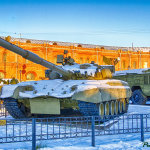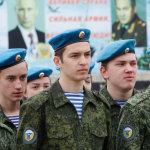The British Army began formal conduct after capture training following the Korean War (1950-53). At the end of the conflict as many as 12,733 allied prisioners were exchanged, including 946 Britons. Their treatment, and especially the American defections, caused a shock. Fashionable notions of communist ‘brainwashing’ were promoted to explain why prisoners had cooperated with their captors. This led to what used to be termed ‘R to I’ (resistance to interrogation) training and the use of the now banned ‘five techniques’. Courses were run at the old Intelligence Corps depot at Ashford (where Argentine submarine Captain Ortiz was held following his capture on South Georgia). The rational was that if you experienced hooding, stress positions, white noise, and other abuses you would be better prepared if captured by communist forces in a future conflict. In 2008, joint training was established under the banner of the Defence Survive, Evade, Resist, Extract (SERE) Training Organisation (DSTO), based at RAF St Mawgan.
The nearly two-year long Russo-Ukrainian War has highlighted the treatment of prisoners. Almost 50 PoW exchanges have now taken place offering a rich source of prisoner testimonies, documented by organisations such as OHCHR (The Office of the United Nations High Commissioner for Human Rights). This article describes what to expect if you are captured by Russian forces.

Contempt for the Geneva Conventions: Russian forces in Ukraine and penal authorities in Russia have displayed contempt for the Geneva Conventions on the Treatment of Prisoners of War. This reflects wider Russian contempt for international jurisprudence, viewed – much like the Nazi regime – as a set of rules designed by the ‘old powers’ to constrain the rightful destiny of a great ‘civilisational-country’ as President Putin paints Russia. It also reflects an appalling penal culture in Russia, described in Aleksandr Solzhenytsin’s epic three-volume The Gulag Archipelago. There is little in how Ukrainian PoWs have been treated that would suggest a British PoW would be treated correctly.
Executions: In December 2022, shock was caused when a 42-year old Ukrainian prisoner, Oleksandr Matsievskyi, was shot by Russian soldiers after saying ‘Slava Ukraini’ (‘Glory to Ukraine) (a statue has since been erected in his memory). OHCHR has authenticated this case as well as six other extrajudicial killings of Ukrainian prisoners. Towards the end of 2023, Ukrainian drone pilots recorded two instances of Ukrainian soldiers surrendering in trench lines, made to lie face down, and executed. Drone footage has also shown Ukrainian soldiers being used as human shields and forced to advance in front of Russian soldiers. Unaccountable elements of the Russian armed forces such as Wagner have been heavily implicated in prisoner executions, highlighted in a Media Initiative for Human Rights report. These have included mass executions, beheadings, and the placing of decapitated heads on poles to taunt other PoWs. One prisoner remembered:
‘They showed me the freshly severed heads of our guys, mounted on poles. One of them said: ‘This is Edik, and this is Valera. They wanted everything to be done according to the Geneva Conventions. Do you want to do it according to the conventions too? There is room for a third.’’
Beatings: In scenes reminiscent of Nazi concentration camp guards, multiple prisoner testimonies have described being forced to pass through a tunnel of guards and beaten on arrival at a camp. This is the description of ‘Serhiy Lebedev’ (a pseudonym):
‘When prisoners of war were brought to the colony, guards with rubber batons lined up near the buses. The prisoners were chased through the formation – mercilessly beaten with sticks. It happened that arms and legs were broken. And in the future they were also beaten. There were cases when prisoners were beaten to death.’
Another prisoner, Mariupol volunteer Kostyantyn Velychko, told:
‘At that time, a lot of arrested people were brought to the colony in buses – 844 people. The arrested person was literally kicked out of the bus to the ground and chased through the formation. To the left and to the right – a row of escorts. Some have belts in their hands, some have clubs, some have shovels. And now a prisoner of war is being driven through this row. People fall, and they are beaten until they get up. Well, one guy didn’t make it to the end… I don’t know who it was. An ordinary soldier.’
Prisoners beaten in captivity were expected to answer ‘I fell over’ when mocked by a guard over a bruised face.
Torture: Many torture chambers have been found in liberated areas of Kherson and Kharkiv Oblasts, typically pointed out by locals. As many as 22 such ‘detention centres’ were found in the latter province alone. In the former, 63 bodies were found with evidence of torture following the withdrawal of Russian forces. In a basement in a village named Pisky-Radkivski, Ukrainian forces found a dildo, an old gas mask, a box containing extracted gold, dental crowns, and a discarded interrogation report. Typical torture methods are electrocutions, setting prisoners on fire, taping prisoners in uncomfortable positions then beating them, and mutilations (cutting off ears and removing fingernails). One prisoner related:
‘They wrap you up using wide scotch tape, with your arms at your side, with the tape going all the way to your knees. You find yourself as if in a cocoon. And they start beating you. At first you feel intense pain, but then everything goes numb. I thought I would lose my hands.’

Overcrowded cells: Multiple testimonies report prisoners forced into overcrowded cells – as many as 50 squeezed into a six-man cell – forcing the prisoners to sleep in shifts and stand for hours on end. Prisoners who need to go to the toilet are made to wait until the end of the day. The prisoners share one spoon for eating.
Underfeeding and starvation: Prisoners have reported not being fed at all in their first days of captivity to weaken them physically and psychologically. Later, detained journalist Oleg Baturin recalled, he was fed a 350 gram ration of millet with stew once a day. Female prisoners at Olenivka were fed one meal a day comprising 50 grams of bread and porridge. Ukrainian kickboxing champion Oleksiy Anulia who was released this December weighed 102 kilograms before capture. He lost 40 kilograms in weight during his captivity. Anulia described breakfast as ‘a piece of bread and two spoons of groats and water in which the Russians had boiled their buckwheat or rice. For lunch, there was a watery soup with cabbage, and for dinner, again, chaff mixed with water. Sometimes, the prisoners received boiled fish intestines with the heads.’ He was released after one year and ten months in captivity. 108 days had been spent in solitary confinement.

Prisoner confession videos: Forced prisoner confession videos are posted every week (via the pro-Kremlin Voennoye Obozreniye(‘Military Review’)). Common themes include: ‘our equipment is poor’, ‘our commanders force us to make ‘meat attacks’’, everybody in my unit was killed’, and ‘I think the war is lost’. The videos serve the secondary purpose of adding psychological pressure on families.
Psychological torment and petty harassment: Prisoners have reported being forced to dig their own graves, then ‘reprieved’. Others have been told Ukraine no longer existed and nobody cared about them. Pointless strip searches have been enforced and prisoners left naked for hours. They have been forced to learn and then sing the Russian national anthem every day. Prisoners have been ordered to shout ‘Zelensky is a f**ker, Biden is a f**ker, Stoltenberg is a f**ker, Putin is our president!’ A 45-year-old Ukrainian entrepreneur named Anna Vorosheva who was held for 100 days at the notorious Olenivka perfectly sketched the mentality of the captors. The camp guards displayed the sadistic psychology of all concentration camp guards: ‘Everything is horrible for us, so everything should be horrible for you.’ It was all very communist.
Exploiting PoW families to pressure Kyiv: As the war has lengthened so Moscow has made the cynical calculation that it can increase pressure on Kyiv by stalling on prisoner exchanges. In Russia the mobilised soldiers’ wives and mothers movement Put’ Domoi is suppressed. Protests by the families of prisoners in Ukraine are not and have been vocal. The tactic highlights that PoW families require support and in an age of social media protection from trolling.

Clergy and medical personnel: Russian forces have been obsessed with detaining clergy – because the FSB/GRU had been using Ukrainian Orthodox Church of the Moscow Patriarchate (UOC-MP) clergy as spies and subversive elements, and so assumed other denominations were necessarily ‘enemy’ clergy. Protestant clergy have been especially singled out (described as ‘American spies’). Captured medical personnel have not fared much better. The chaplain (a 64-year old) and doctor who volunteered to go to Zmiinyi (Snake) Island following the invasion were detained as a ‘spies’ and terribly abused. When the pair finally arrived at a camp in Russia, at night and in temperatures of -22 degrees centigrade, ‘all of us, 200 people, were forced to kneel, then we were beaten. Just like that, for no reason. We were on our knees for two hours. Terribly cold.’ They were released 43 days later along with three International Red Cross workers (including two females) who had similarly been detained as ‘spies’. A more celebrated case in Ukraine is the recent December release of combat medic Galina Fedyshyn. She was captured in the Azovstal steelworks in Mariupol at the beginning of the war. It has taken 20 months to secure her release.
Organisational, race and cultural differences: Abundant civilian and military prisoner testimonies reveal organisational, race and cultural differences in the behaviour of Russian military and security forces. The worst behaved are Siberians and Eastern Russians (Buryats and Tuvans – Defence Minister Shoigu’s home territory). Separatist captors have also behaved abysmally, in envy over Ukrainians living ‘on the other side’ in freedom. Following the massacre by a large explosive charge of Azov PoWs at Olenivka, local guards gathered at the fence and laughed at the wounded survivors rather than offer help. A Ukrainian doctor who approached the scene 40 minutes after the explosion found ‘a huge number of wounded’ writhing in pain and screaming for help in the dark. Those who survived had suffered burns, shrapnel wounds and traumatic amputations. Following this terrible incident, the Russian Embassy in London posted on its Twitter account: ‘Azov fighters deserve to be killed, but not by shooting, but by hanging, because they are not real soldiers. They deserve a humiliating death.’
Concluding thoughts
President Putin boasts about Russkiy Mir (‘Russian world’) and continuously waffles about Russia as a great ‘civilizational-country’. The reality is that he has opened a Pandora’s Box of horrors. Sadism and brutality not witnessed since WW2 (with the exception of the behaviour of the Bosnian Serbs in the 1990s) has returned to Europe. Hellish journeys have been experienced by captured and detained Ukrainian service personnel and civilians. This may be the moment to review British armed forces doctrine and training for conduct after capture.
Sergio Miller
Sergio Miller is a retired British Army Intelligence Corps officer. He was a regular contributor and book reviewer forBritish Army Review. He is the author of a two-part history of the Vietnam War (Osprey/Bloomsbury) and is currently drafting a history of the Russian invasion of Ukraine.





